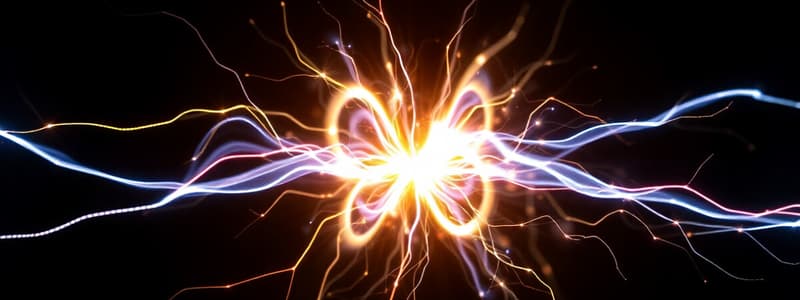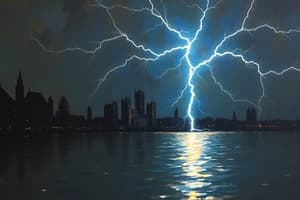Podcast
Questions and Answers
What are the two types of electric charge?
What are the two types of electric charge?
- Positive and infinite
- Negative and neutral
- Positive and negative (correct)
- Positive and neutral
What is the charge of a proton?
What is the charge of a proton?
- +e (correct)
- 0
- 2e
- -e
Like charges
Like charges
- Have no interaction
- Repel each other (correct)
- Cancel each other
- Attract each other
In the SI system of units, what unit is used to measure electric charge?
In the SI system of units, what unit is used to measure electric charge?
What is the approximate value of the elementary charge, e?
What is the approximate value of the elementary charge, e?
What does it mean when an object has a net charge of q = 0?
What does it mean when an object has a net charge of q = 0?
What does Coulomb's Law describe?
What does Coulomb's Law describe?
In Coulomb's Law, what does the variable 'r' represent?
In Coulomb's Law, what does the variable 'r' represent?
What condition should be met for Coulomb's Law to be accurate?
What condition should be met for Coulomb's Law to be accurate?
What does the term $\epsilon_0$ represent in the alternative formula for Coulomb's Law?
What does the term $\epsilon_0$ represent in the alternative formula for Coulomb's Law?
What is the approximate value of the permittivity of free space ($\epsilon_0$)?
What is the approximate value of the permittivity of free space ($\epsilon_0$)?
How are the constants $k$ and $\epsilon_0$ related in Coulomb's Law?
How are the constants $k$ and $\epsilon_0$ related in Coulomb's Law?
In coal burning power plants, what is the initial step in removing soot particles from smoke using scrubbers?
In coal burning power plants, what is the initial step in removing soot particles from smoke using scrubbers?
What is the primary difference between gravitational and electric forces?
What is the primary difference between gravitational and electric forces?
What is the purpose of scrubbers in modern smokestacks?
What is the purpose of scrubbers in modern smokestacks?
Why are soot particles charged in scrubbers?
Why are soot particles charged in scrubbers?
Flashcards
Coulomb's Law
Coulomb's Law
A formula calculating the electric force between two charges.
Permittivity of Free Space
Permittivity of Free Space
A constant (ε₀) that affects the electric force in a vacuum: 8.85 × 10⁻¹² N·m²/C².
Electric Force (F)
Electric Force (F)
The force between two charges, calculated by F = (q₁q₂)/(4πε₀r²).
Gravitational Force vs. Electric Force
Gravitational Force vs. Electric Force
Signup and view all the flashcards
Activity Example: Electric Force Calculation
Activity Example: Electric Force Calculation
Signup and view all the flashcards
Electric Charge of Soot Particle
Electric Charge of Soot Particle
Signup and view all the flashcards
Number of Electrons Required
Number of Electrons Required
Signup and view all the flashcards
Coulomb's Law Restrictions
Coulomb's Law Restrictions
Signup and view all the flashcards
Electric Charge
Electric Charge
Signup and view all the flashcards
Types of Electric Charge
Types of Electric Charge
Signup and view all the flashcards
Coulomb’s Law
Coulomb’s Law
Signup and view all the flashcards
Charge Conservation
Charge Conservation
Signup and view all the flashcards
Proton Charge
Proton Charge
Signup and view all the flashcards
Electron Charge
Electron Charge
Signup and view all the flashcards
Total Charge Notation
Total Charge Notation
Signup and view all the flashcards
Charge Quantization
Charge Quantization
Signup and view all the flashcards
Study Notes
General Physics 2: Electric Charge
- Electric charge is a fundamental property of matter
- Two types: positive and negative
- Protons have a positive charge (+e)
- Electrons have a negative charge (-e)
- Charge is quantized; all protons have the same +e charge and all electrons have the same -e charge
- Charge is conserved: the total charge of the universe remains constant
- Like charges repel, unlike charges attract
- Charge is measured in coulombs (C)
Coulomb's Law
- Describes the force between two charged objects
- Force is directly proportional to the product of the charges and inversely proportional to the square of the distance between them
- F = k * q₁q₂ / r²
- k = 8.99 × 10⁹ N • m²/C² (Coulomb constant)
- Force is along the line connecting the charges
- The objects should be small compared to their separation.
Charge of Electrons and Protons
- Electron charge = -1.60 x 10⁻¹⁹ C
- Proton charge = +1.60 x 10⁻¹⁹ C
- 1C = 6.25 x 10¹⁸ e (electrons/protons)
Notations and Rules
- q or Q denote the total charge of an object (can be positive, negative or zero)
- q=0 doesn't mean no charge, it means equal number of protons and electrons
- e represents charge of proton
Alternative Formula
-
F = q₁q₂ / 4πε₀r²
- ε₀ = 8.85 x 10⁻¹² C²/N⋅m² (permittivity of free space)
-
The values of ε₀ and k are related by 1 / (4πε₀) = k
Restrictions of Coulomb's Law
- Objects must be very small in comparison to their separation.
Studying That Suits You
Use AI to generate personalized quizzes and flashcards to suit your learning preferences.




